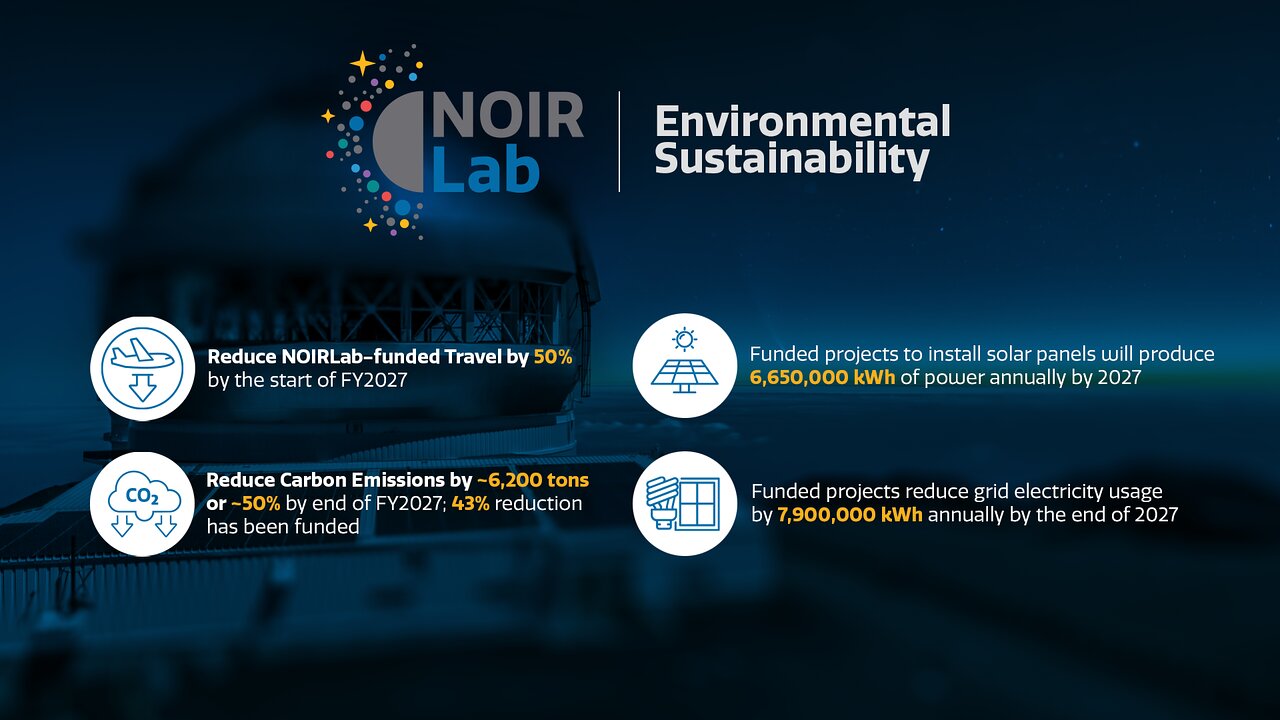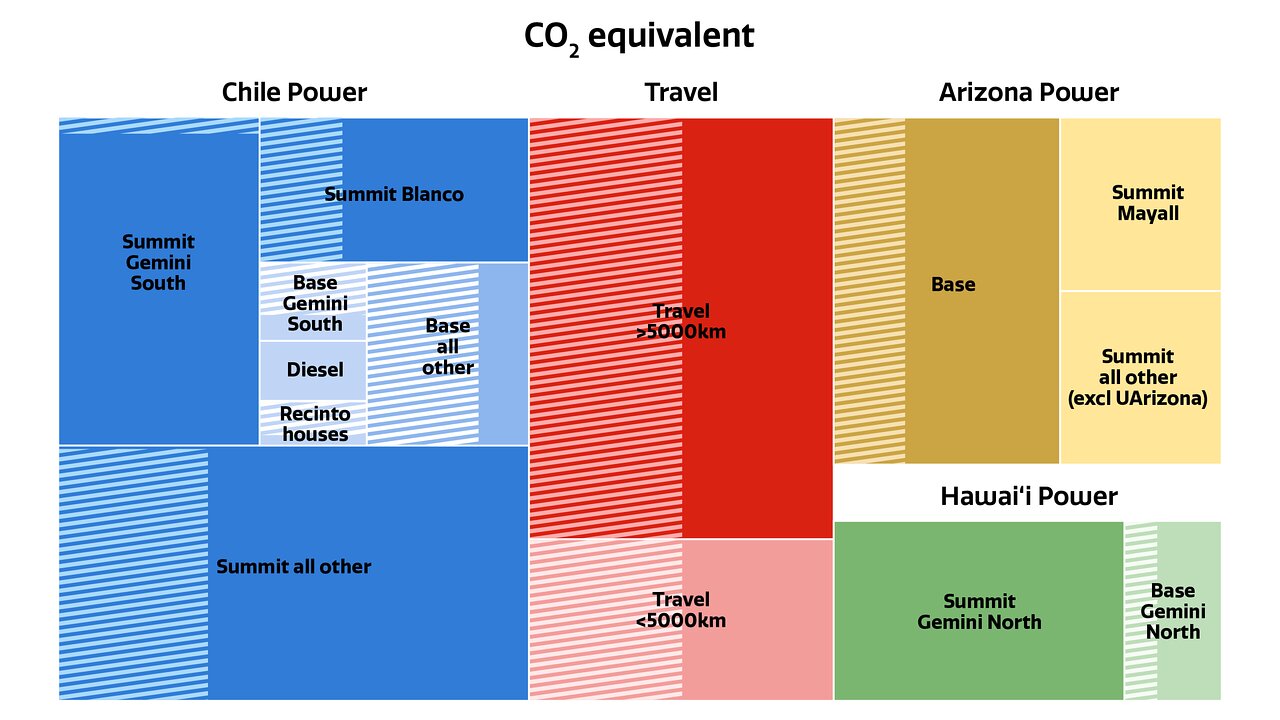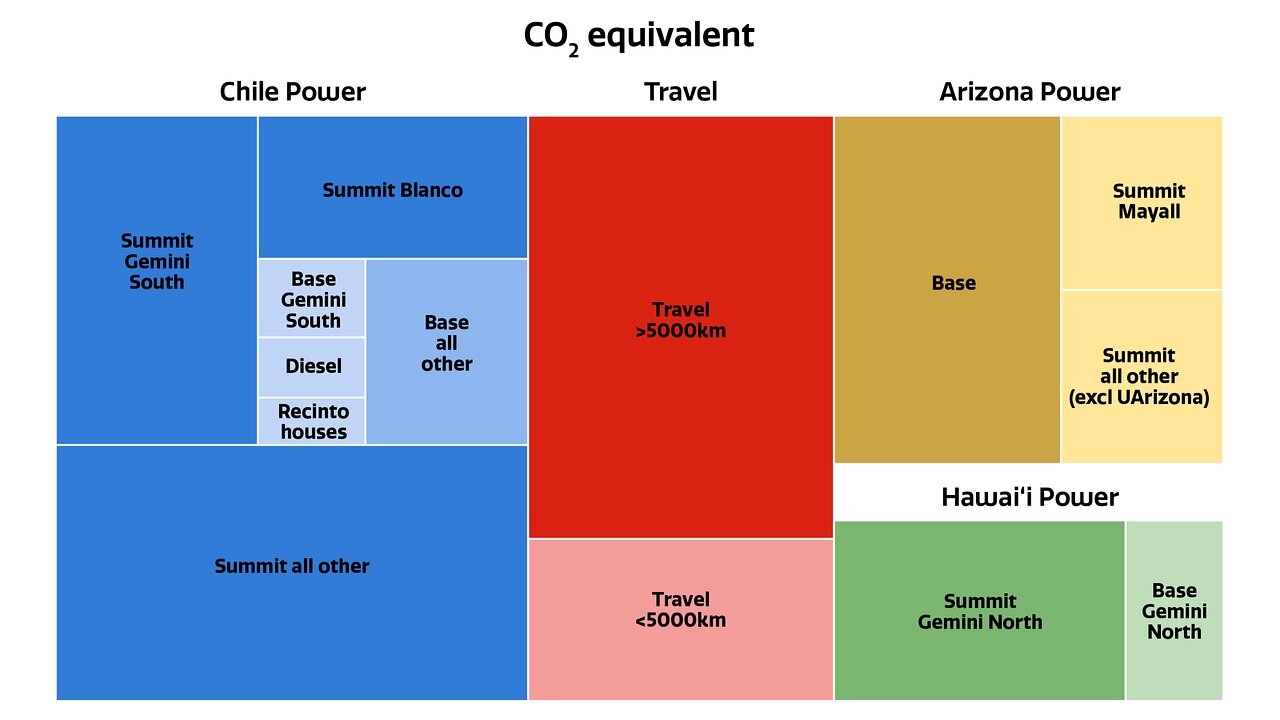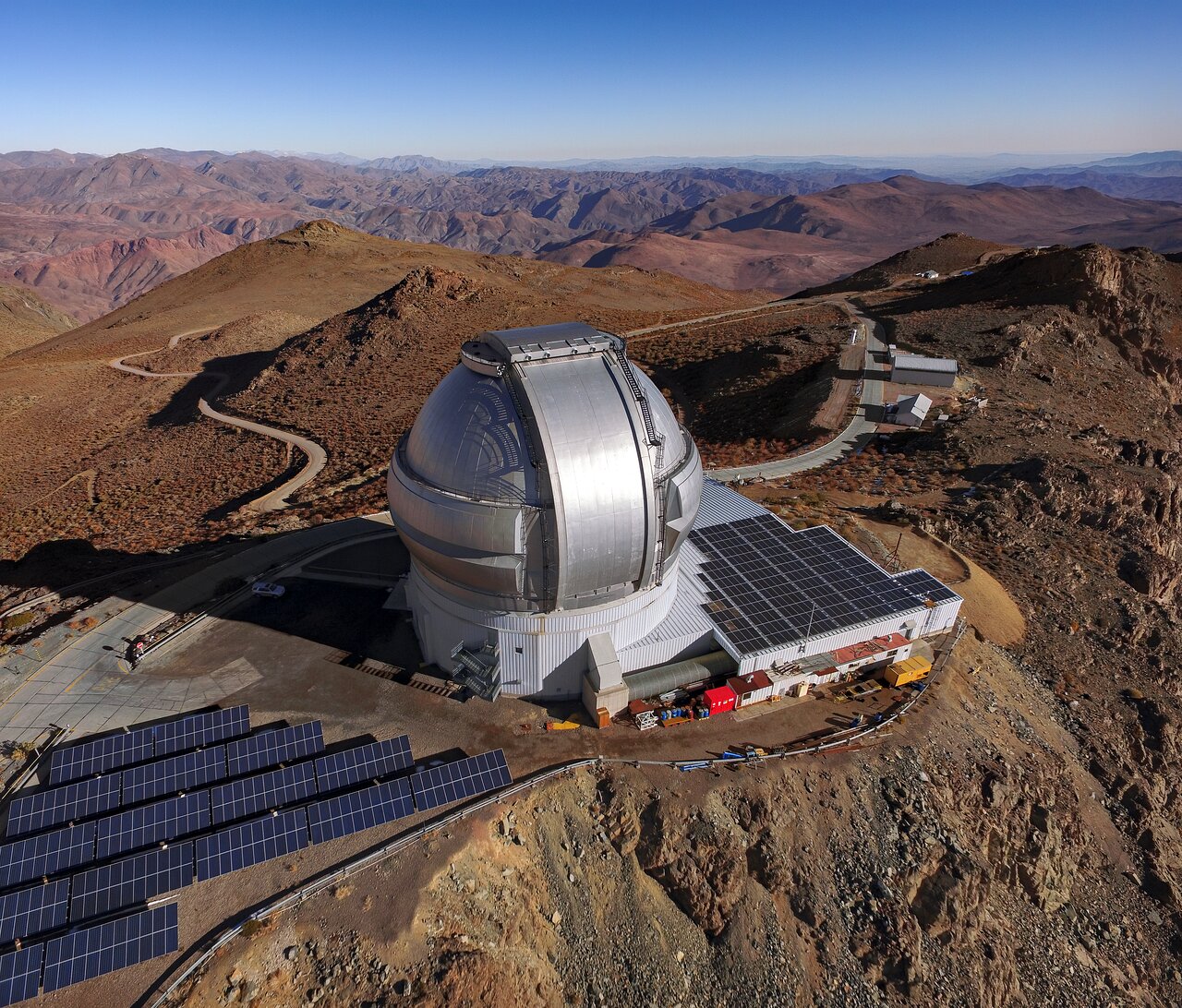Programa de Sustentabilidad Medioambiental de NOIRLab
Administradores de la Tierra y el Cielo
Ser un buen administrador de la Tierra y el Cielo es un principio fundamental para NOIRLab. Este compromiso parte en nuestras comunidades anfitrionas locales de Arizona, Chile y Hawai‘i. Los pasos hacia la sustentabilidad incluyen la reducción de la huella de carbono de nuestras actividades, preservar los cielos oscuros y estar atentos a las tierras que albergan nuestras instalaciones. Esta página destaca las actividades de NOIRLab que hacen que nuestras operaciones sean más sustentables desde el punto de vista medioambiental.
El Informe Decenal ASTRO2020 "Pathways to Discovery" recomienda las siguientes acciones para abordar el cambio climático "...aumentar el uso de la observación remota, las conferencias híbridas y remotas, para reducir el impacto de los viajes en las emisiones de carbono y el cambio climático".
A través de su Programa de Sustentabilidad, NOIRLab está comprometido a realizar operaciones con más sustentabilidad medioambiental al reducir los viajes de su personal y el consumo de energía de la red eléctrica de las instalaciones.
La meta actual de NOIRLab es reducir nuestra huella de carbono a un 30% aprox. desde su tamaño estimado de 8.700 toneladas equivalentes de CO2 (2019) a un valor meta de unas 6.200 toneladas equivalentes de CO2 para finales de 2027. Esta reducción equivaldrá a la huella de carbono del consumo anual de electricidad de 500 casas de EE.UU. Estos valores aún no incluyen los valores del Observatorio Vera C. Rubin en Cerro Pachón, que se espera inicie sus operaciones en 2024.
Esta reducción se logrará utilizando un enfoque de dos niveles:
- Reducir los viajes financiados por NOIRLab en aproximadamente un 50% para el inicio del año fiscal 2026.
- Invertir los fondos de la reducción de los viajes en:
- Equipos con eficiencia energética
- Paneles solares adicionales, también conocidos como paneles fotovoltaicos.

Resumen de las actividades de sustentabilidad medioambiental actualmente en curso en NOIRLab.
Representación de la huella de carbono de NOIRLab en 2019. El área de cada rectángulo es proporcional a la huella de carbono de la actividad o instalación nombrada. Esto incluye electricidad, uso de diésel como energía de respaldo y viajes.
Mejoras en Sustentabilidad
Como una instalación financiada por el gobierno federal, NOIRLab tiene tanto la oportunidad como la obligación de dar el ejemplo cambiando la forma de operar para minimizar nuestro impacto ambiental, y compartiendo este cambio con el público y la comunidad.
En los últimos años, muchos observatorios de NOIRLab, y los de nuestros socios, han optimizado sus operaciones nocturnas y han reducido su huella de carbono en la cumbre mediante la observación remota y, cada vez más, con la automatización. Esto minimiza los costos operacionales y hace que los observatorios estén en mejor armonía con su entorno natural. La energía solar, apoyada por el almacenamiento local de baterías, y complementada por la red eléctrica verde (según sea necesario), puede reducir la huella de CO2 de NOIRLab.
Arizona
La Sede Central de NOIRLab se encuentra en Tucson, Arizona. Las mejoras planificadas de sustentabilidad en este lugar incluyen:
- Instalación de transformadores de la eficiencia;
- Reemplazo de ventanas para utilizar ventanas de doble panel en toda la instalación;
- Iluminación LED;
- Reconfiguración del Data Center para utilizar una disposición de zonas frías/calientes;
- Instalación de un sistema fotovoltaico de 222 kW en el techo del edificio.
El financiamiento de estas mejoras abarca un período de implementación para los años 2023-2027.
Diseño del sistema fotovoltaico planificado en Tucson, Arizona.
Chile
Las siguientes mejoras están planificadas tanto para las oficinas en La Serena como para las instalaciones de montaña en Cerro Tololo y Cerro Pachón:
- Instalación de transformadores de alta eficiencia e iluminación LED en el Recinto de AURA en La Serena, Cerro Tololo y Cerro Pachón;
- Gestión energética del Data Center en La Serena y en el Observatorio Rubin;
- Instalaciones fotovoltaicas con la siguiente capacidad nominal de recolección:
- Sistemas de 193 kW + 200 kW en las instalaciones de La Serena;
- 200 kW en el Observatorio Cerro Tololo (CTIO);
- 200 kW en el Observatorio Rubin en Cerro Pachón.
El financiamiento de estas mejoras también abarca un período de implementación para los años 2023-2027.
NOIRLab también recibió financiamiento adicional de la Fundación Nacional de Ciencias (NSF) de Estados Unidos para instalar una adición de 810 kW al actual sistema fotovoltaico cerca de Gemini Sur en Cerro Pachón. La adición de almacenamiento de baterías a este sistema en el futuro haría que las operaciones de montaña en Gemini Sur fueran neutrales en el uso de electricidad. El sistema fotovoltaico de 810 kW se instalará en el pequeño valle situado bajo Gemini Sur.
Además, el gobierno chileno pretende aumentar el componente de energía renovable de su producción de electricidad del 11% en 2016 al 40% en 2030, disminuyendo aún más la fracción de electricidad producida con combustibles fósiles que se utiliza en las instalaciones de Chile.
Captura de dron que muestra la vista aérea de Gemini Sur en la pre-cordillera de los Andes en el norte de Chile. Los paneles fotovoltaicos se instalaron en 2016 y abastecen alrededor de un 20% de la energía necesaria para el funcionamiento del telescopio.
Créditos: Observatorio Internacional Gemini/NOIRLab/NSF/AURA
Hawai‘i
Ya se han llevado a cabo numerosos proyectos de energía sostenible en las instalaciones de NOIRLab en Hilo y en Maunakea. Un sistema fotovoltaico de 100 kW en Maunakea proporciona aproximadamente el 12% de la electricidad necesaria para el funcionamiento del telescopio Gemini Norte, y un sistema fotovoltaico de 100 kW en la Instalación Base de Gemini Norte proporciona aproximadamente el 20% de la electricidad que se necesita en ese lugar. La instalación de luces LED y transformadores de alta eficiencia, así como el reemplazo de enfriadores y la reconfiguración del Data Center, se realizaron en el período 2015-2018.
NOIRLab también añadirá 100 kW al sistema fotovoltaico existente en Hilo.
El sistema fotovoltaico en el techo de la Instalación Base de Gemini Norte. Este sistema proporciona alrededor del 20% de la energía necesaria en el lugar.
Créditos: Observatorio Internacional Gemini/NOIRLab de NSF/AURA/J. Pollard
Telescopio Gemini Norte en Hawaiʻi. El sistema fotovoltaico en el techo del edificio de apoyo proporciona aproximadamente un 12% de la electricidad necesaria para el funcionamiento del telescopio. Este sistema se instaló en 2015.
Créditos: Observatorio Internacional Gemini/NOIRLab/NSF/AURA/A. Hara
Reducción de Huella de Carbono Esperada
Como se muestra en la imagen de abajo, los proyectos del Programa de Sustentabilidad de NOIRLab reducirán la huella de carbono de NOIRLab en un 30% para finales de 2027.
Referencia de la huella de carbono de 2019 con una superposición sombreada que muestra la reducción prevista del 30% de la huella de carbono para finales de 2027 como resultado de los proyectos del Programa de Sustentabilidad de NOIRLab.
NOIRLab está buscando activamente financiamiento para llevar a cabo otros proyectos de eficiencia energética, entre los que se incluyen:
- Reemplazo del sistema de aire acondicionado y ventilación de la Sede Central;
- Un sistema fotovoltaico para el Observatorio Nacional Kitt Peak, pendiente para su discusión con la Nación Tohono O'odham;
- Transformadores adicionales de alta eficiencia y reemplazo de ventanas/puertas en Kitt Peak y en la Sede Central;
- Cargadores de vehículos eléctricos en todos los sitios y un cambio gradual a una flota de vehículos totalmente eléctricos;
- Un sistema fotovoltaico más grande para abastecer completamente todas las instalaciones de Cerro Pachón, incluyendo el Observatorio Rubin.
La puesta en marcha de estos proyectos puede suponer una reducción total de la huella de carbono de alrededor del 50%.




